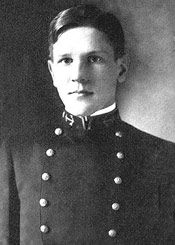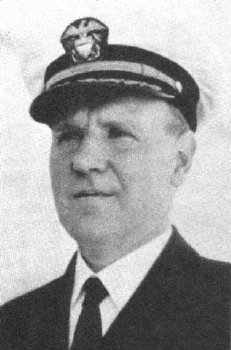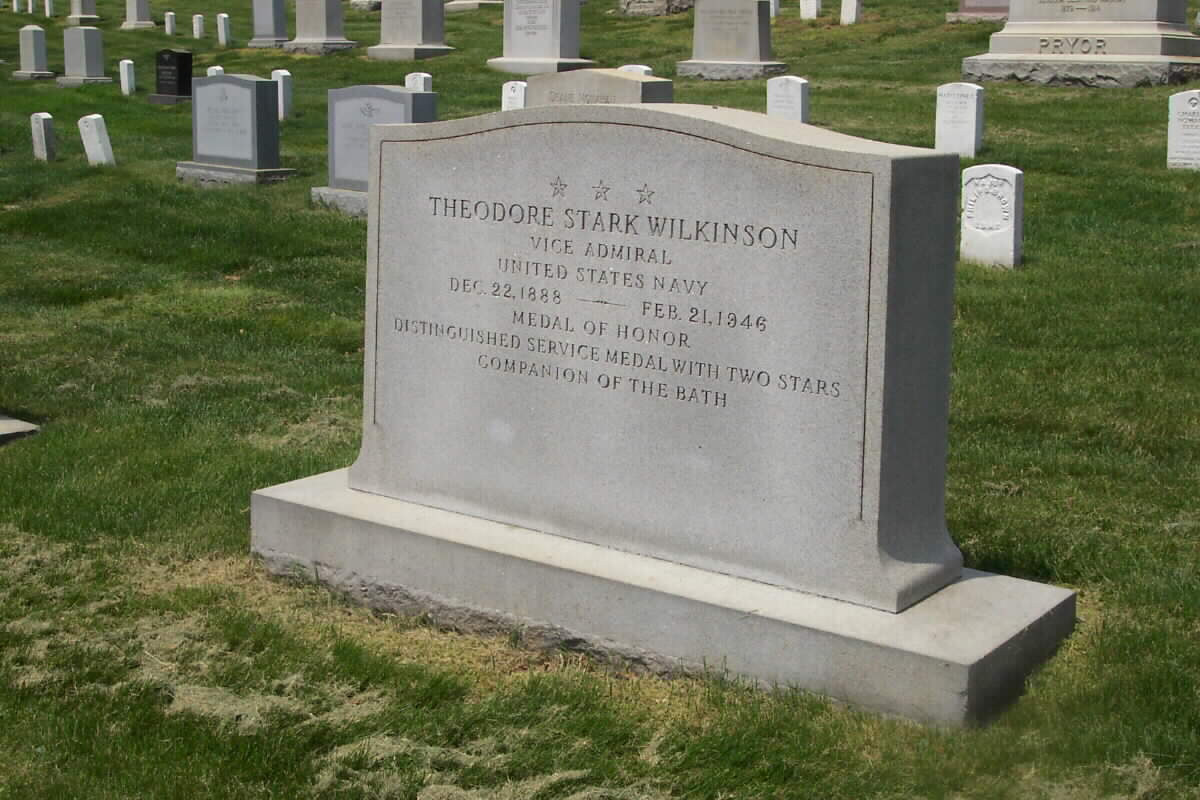Born December 22, 1888, at Annapolis, Maryland, he graduated from the US Naval Academy in 1909 (1st in the class) and was commissioned an Ensign two years later.
In the occupation of Vera Cruz, Mexico, April 1914, he led a raiding party from the USS Florida that captured the customs house, an exploit for which he earned the Medal of Honor.
During World War I he attached to the Bureau of Ordnance where he helped perfect anti-submarine depth charges like the Mark VI USN mine that was heavily used in the mine screen laid across the North Sea.
Various routine assignments, including the command of a destroyer and in 1931-34 secretaryship of the General Board of the US Navy. He was promoted to Captain in 1937. In October 1941, after a few months in command of battleship the Mississippi, he was named Director of the Office of Naval Intelligence. In that post was responsible for the gathering (but not interpreting – forwarding to field) intelligence relating particularly to Japanese intentions for war. In November he was promoted to Rear Admiral. In August 1942-January 1943 he commanded Battleship Division 2, and in the latter month was named Deputy Commander of the South Pacific Force under William F. Halsey. After holding that post throughout campaign in Central Solomons, he succeeded Admiral R. Kelly Turner as Commander of the 3rd Amphibious Force (III ‘Phib) in July 1943. Destroyer forces under his command won naval battle of Vella Gulf, August 6-7, and directed the landing of troops on Vella Lavella beginning August 15 and the naval battles around that island through October. On November 1, in a major jump in the “leapfrog” strategy employed in Pacific islands, he landed 14,000 men of Alexander A. Vandegrift’s I Amphibious Corps at Empress Augusta Bay on Bougainville. In September 1944, after directing the long-planned assault on Peleliu in the Palau Islands on the 15th and Ulithi Atoll on the 23rd, he quickly shifted his forces from the canceled Yap campaign to the recently moved up Philippines invasion, redeploying brilliantly to make the scheduled landing on John R. Hodge’s XXIV Corps at Dulag, Leyte, on October 20.
He was promoted to Vice Admiral following that accomplishment, and he overcame heavy opposition, including furious kamikaze attacks, to put a corps of Walter Krueger’s 6th Army ashore at Lingayen Gulf, Luzon, January 1945, cooperating with Admiral Daniel E. Barbey in that operation. In September III ‘Phib conveyed Robert L. Eichelberger’s 8th Army to Japan for occupation duty.
In January 1946 named to Joint Strategic Survey Committee of the Joint Chiefs of Staff. Died when an auto is accidentally driven off ferry at Norfolk, Virginia, February 21, 1946. He was buried in Section 2, Grave 3465, Arlington National Cemetery, adjacent to his father, Ernest Wilkinson, Ensign, United States Navy.
WILKINSON, THEODORE STARK
- VICE ADMIRAL USN
- VETERAN SERVICE DATES: Unknown
- DATE OF DEATH: 02/21/1946
- DATE OF INTERMENT: 02/25/1946
- BURIED AT: SECTION 2 SITE 3465
ARLINGTON NATIONAL CEMETERY
WILKINSON, THEODORE STARK, JR
Rank and organization: Ensign, U.S. Navy. Born: 22 December 1888, Annapolis, Maryland. Appointed from: Louisiana. G.O. No.: 177, 4 December 1915. Other Navy award: Distinguished Service Medal with gold stars in lieu of 2 additional DSM’s.
Citation:
For distinguished conduct in battle, engagements of Vera Cruz, 21 and 22 April 1914. Ensign. Wilkinson was in both days’ fighting at the head of his company and was eminent and conspicuous in his conduct, leading his men with skill and courage.
ADMIRAL DROWNS AFTER SAVING WIFE
Wilkinson Pushes Her Out of Car as It Falls Into River From Ferry at Norfolk
A Leader in Pacific War
Holder of Medal of Honor, He had Amphibious Command
Headed Intelligence in ‘41
NORFOLK, Virginia, February 21, 1946 – Vice Admiral Theodore S. Wilkinson was drowned today when his automobile plunged from a ferry into the Elizabeth River, but he saved his wife’s life by pushing her from the car a second before it sank.
Mrs. Catherine Wilkinson, wife of the 57-year-old officer who distinguished himself in the South Pacific as commander of the Third Amphibious Force, Third Fleet, said that he lost control of the car and when he realized that they were going off the front end of the boat he opened the door, yelled “jump” and shoved her out.
Mrs. Wilkinson was rescued by employees of the Norfolk-Portsmouth Ferries and taken to a Naval Hospital for treatment of shock and exposure. Admiral Wilkinson’s body was recovered about seventy-five minutes after the accident by a diver who removed it from under the steering wheel of the automobile.
The admiral was unfamiliar with the car, having borrowed it from a friend, his wife said. A court of inquiry will be appointed to investigate the accident, which occurred as the couple was going from their home in Washington, D.C. to Charleston, South Carolina.
Luke Piland, a deck hand on the ferry West Point, said the automobile boarded the ferry and rolled down the port lane at high speed, which appeared to increase as the driver leaned forward as though reaching for something on the floor. Piland said he threw a block beneath a wheel of the car but the vehicle went over the block and crashed through the forward chain and gate, grazing the fender of an automobile parked at the bow of the starboard lane.
Ferry employees said the automobile’s engine was racing while the car was parked on the street in Norfolk awaiting arrival of the boat and that Admiral Wilkinson alighted from the car, reached to the floor and the engine stopped racing. It was believed that the accelerator pedal was not working properly. The car was recovered later in the morning.
Admiral Wilkinson – “Ping” Wilkinson as he was known throughout the Pacific Fleer – was one of the Navy’s leaders in amphibious warfare, a Congressional Medal of Honor man whose name was associated with great Pacific victories in the Second World War: New Georgia, Vella Lavella, Treasury Island, Bougainville, Peleliu and Angaur in the Palaus and Leyte and Lingayen Gulf in the Philippines.
The tall, sandy-haired Admiral held top-tanking posts during the war, including Deputy Commander of the South Pacific Area and Commander of the Third Amphibious Force, Third Fleet. He closed his forty-year career in the Navy as a member of the Joint Strategic Survey Committee of the Joint Chiefs of Staff, a job that only started last month.
Admiral Wilkinson was Chief of Naval Intelligence at the time of Pearl Harbor, and was one of the witnesses recently at the Congressional hearings on the disaster. He told the committee that Japan’s final “fighting” message, calling for war with the United States, was deciphered in full and delivered by himself to the Chief of Naval Operations some four hours before Hawaii was attacked.
The Admiral was an ardent sportsman while at the Naval Academy, where he received the “N” for track and his nickname “Ping” for his love of tennis and ping-pong.
Admiral Wilkinson’s career as a master of amphibious warfare had a dramatic beginning thirty-two years ago when, as an Ensign on the battleship Florida, he led a company of sailors in a landing force sent ashore at Vera Cruz, Mexico. The action culminated in the seizure of the Vera Cruz Customs House on April 22, 1914. It was for this action that he received the nation’s highest decoration.
The Admiral was born December 22, 1888 at Annapolis, Maryland, and was appointed to the Naval Academy in 1905. He was first in his graduating class. After filling various posts on land and sea, including assistant to the naval attaché at Paris, Admiral Wilkinson became Secretary of the Navy’s General Board in 1931. He attended the disarmament conferences in Europe.
For three years, beginning in 1936, Admiral Wilkinson was bead of the Planning Division, Bureau of Navigation, and in early 1941 he assumed command of the battleship Mississippi. In the summer of 1942, after he had been Chief of Naval Intelligence for about ten months, he took command of a battleship division and on January 30, 1943, he became Deputy Commander, South Pacific Area, and South Pacific Force. Five months afterward he assumed command of the amphibious force, South Pacific, and later of the Third Amphibious Force.
Survivors include, besides his wife, his mother, who lived in Washington, D.C.; two daughters, Mrs. George Hall of Detroit and Mrs. Ralph Hunter of Hanover, New Hampshire; and a son, Theodore Jr, aged 11.
WILKINSON FUNERAL HELD
Forrestal, Nimitz at Rites for Admiral Who Was Drowned
WASHINGTON, February 25, 1946 – Secretary of the Navy James Forrestal and Fleet Admiral Chester W. Nimitz, Chief of Naval Operations, attended the funeral service and burial of Vice Admiral Theodore S. Wilkinson today.
The service, held at St. John’s Episcopal Church, was followed by burial with full military honors in Arlington National Cemetery.
Admiral Wilkinson, a former Chief of Naval Intelligence, was drowned Thursday in Norfolk when the automobile he was driving plunged from a ferry into the Elizabeth River. His wife escaped.
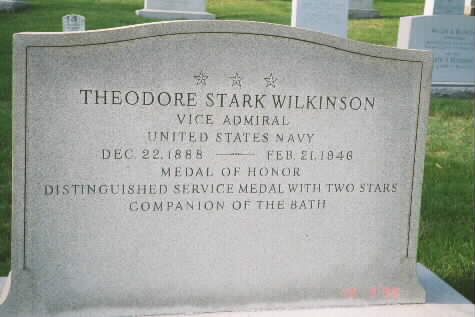
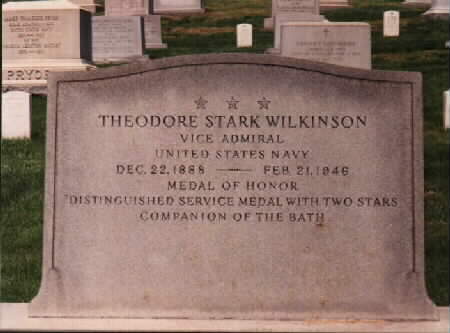
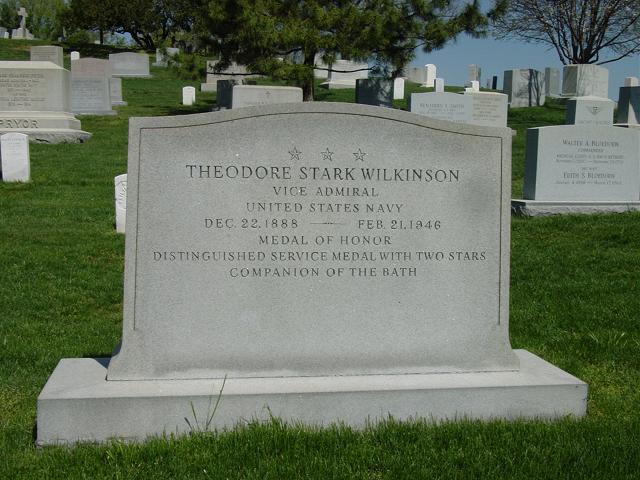
Michael Robert Patterson was born in Arlington and is the son of a former officer of the US Army. So it was no wonder that sooner or later his interests drew him to American history and especially to American military history. Many of his articles can be found on renowned portals like the New York Times, Washingtonpost or Wikipedia.
Reviewed by: Michael Howard


